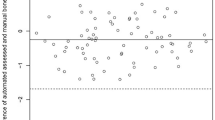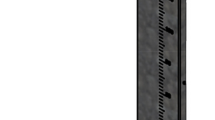Abstract
Summary
Height measurements are currently used to guide imaging decisions that assist in osteoporosis care, but their clinical reliability is largely unknown. We found both clinical height measurements and electronic health record height data to be unreliable. Improvement in height measurement is needed to improve osteoporosis care.
Introduction
The aim of this study is to assess the accuracy and reliability of clinical height measurement in a university healthcare clinical setting.
Methods
Electronic health record (EHR) review, direct measurement of clinical stadiometer accuracy, and observation of staff height measurement technique at outpatient facilities of the University of Wisconsin Hospital and Clinics. We examined 32 clinical stadiometers for reliability and observed 34 clinic staff perform height measurements at 12 outpatient primary care and specialty clinics. An EHR search identified 4711 men and women age 43 to 89 with no known metabolic bone disease who had more than one height measurement over 3 months. The short study period and exclusion were selected to evaluate change in recorded height not due to pathologic processes.
Results
Mean EHR recorded height change (first to last measurement) was −0.02 cm (SD 1.88 cm). Eighteen percent of patients had height measurement differences noted in the EHR of ≥2 cm over 3 months. The technical error of measurement (TEM) was 1.77 cm with a relative TEM of 1.04 %. None of the staff observed performing height measurements followed all recommended height measurement guidelines. Fifty percent of clinic staff reported they on occasion enter patient reported height into the EHR rather than performing a measurement. When performing direct measurements on stadiometers, the mean difference from a gold standard length was 0.24 cm (SD 0.80). Nine percent of stadiometers examined had an error of >1.5 cm.
Conclusions
Clinical height measurements and EHR recorded height results are unreliable. Improvement in this measure is needed as an adjunct to improve osteoporosis care.




Similar content being viewed by others
References
Peter RS, Fromm E, Klenk J, Concin H, Nagel G (2014) Change in height, weight, and body mass index: longitudinal data from Austria. Am J Hum Biol 26(5):690–696
Galbusera F, van Rijsbergen M, Ito K, Huyghe JM, Brayda-Bruno M, Wilke HJ (2014) Ageing and degenerative changes of the intervertebral disc and their impact on spinal flexibility. Eur Spine J 23(Suppl 3):S324–332
Greenspan SL, von Stetten E, Emond SK, Jones L, Parker RA (2001) Instant vertebral assessment: a noninvasive dual X-ray absorptiometry technique to avoid misclassification and clinical mismanagement of osteoporosis. J Clin Densitom 4(4):373–380
Xu W, Perera S, Medich D et al (2011) Height loss, vertebral fractures, and the misclassification of osteoporosis. Bone 48(2):307–311
Schousboe JT, Shepherd JA, Bilezikian JP, Baim S (2013) Executive summary of the 2013 International Society for Clinical Densitometry Position Development Conference on bone densitometry. J Clin Densitom 16(4):455–466
Cosman F, de Beur SJ, LeBoff MS et al (2014) Clinician’s guide to prevention and treatment of osteoporosis. Osteoporos Int 25(10):2359–2381
Oza-Frank R, Hade EM, Conrey EJ (2012) Inter-rater reliability of Ohio school-based overweight and obesity surveillance data. J Acad Nutr Diet 112(9):1410–1414
De Miguel-Etayo P, Mesana MI, Cardon G et al (2014) Reliability of anthropometric measurements in European preschool children: the ToyBox-study. Obes Rev 15(Suppl 3):67–73
Gomez-Cabello A, Vicente-Rodriguez G, Albers U et al (2012) Harmonization process and reliability assessment of anthropometric measurements in the elderly EXERNET multi-centre study. PLoS ONE 7(7), e41752
Stomfai S, Ahrens W, Bammann K et al (2011) Intra- and inter-observer reliability in anthropometric measurements in children. Int J Obes (Lond) 35(Suppl 1):S45–51
Coles RJ, Clements DG, Evans WD (1994) Measurement of height: practical considerations for the study of osteoporosis. Osteoporos Int 4(6):353–356
National Health and Nutritional Examination Survey III. Body Measurements (Anthropometry). 1650 Research Boulevard. Rockville, MD 20850: Westat, Inc.; October 1988
Ohio Department of Health School and Adolescent Health. Guidelines for measuring heights and weights and calculation of body mass index-for-age in Ohio’s SchoolsJuly 2010
Shrout PE, Fleiss JL (1979) Intraclass correlations: uses in assessing rater reliability. Psychol Bull 86(2):420–428
Hilsenroth MJ, Segal DL, Hersen M (2004) Comprehensive handbook of psychological assessment personality assessment. Wiley, Hoboken
Norton K, Olds T. Antropometrica: Biosystem. Antropometrica: Biosystem. 2000
Standing Height Operations Manual. Multicenter osteoarthritis study (MOST); 2009
Jayawardene W, Lohrmann D, YoussefAgha A (2014) Discrepant body mass index: behaviors associated with height and weight misreporting among US adolescents from the National Youth Physical Activity and Nutrition Study. Child Obes 10(3):225–233
Hsiao H, Weaver D, Hsiao J et al (2014) Comparison of measured and self-reported anthropometric information among firefighters: implications and applications. Ergonomics 57(12):1886–1897
Yoon K, Jang SN, Chun H, Cho SI. Self-reported anthropometric information cannot vouch for the accurate assessment of obesity prevalence in populations of middle-aged and older Korean individuals. Arch Gerontol Geriatr. 2014
Healey EL, Burden AM, McEwan IM, Fowler NE (2011) Diurnal variation in stature: do those with chronic low-back pain differ from asymptomatic controls? Clin Biomech (Bristol, Avon) 26(4):331–336
Roberts N, Hogg D, Whitehouse GH, Dangerfield P (1998) Quantitative analysis of diurnal variation in volume and water content of lumbar intervertebral discs. Clin Anat 11(1):1–8
Jamaiyah H, Geeta A, Safiza MN et al (2010) Reliability, technical error of measurements and validity of length and weight measurements for children under two years old in Malaysia. Med J Malaysia 65(Suppl A):131–137
Melton LJ 3rd, Atkinson EJ, Cooper C, O’Fallon WM, Riggs BL (1999) Vertebral fractures predict subsequent fractures. Osteoporos Int 10(3):214–221
Author information
Authors and Affiliations
Corresponding author
Ethics declarations
The University of Wisconsin (UW) Health Sciences Institutional Review Board reviewed and approved this investigation (2014–0536). Additional approval was obtained from the UW General Internal Medicine Research Committee, Department of Family Medicine Research Committee, and written consent from clinic managers at each site.
Conflicts of interest
Anthony Mikula, Scott Hetzel, Neil Binkley, and Paul Anderson declare that they have no conflicts of interest.
Rights and permissions
About this article
Cite this article
Mikula, A.L., Hetzel, S.J., Binkley, N. et al. Clinical height measurements are unreliable: a call for improvement. Osteoporos Int 27, 3041–3047 (2016). https://doi.org/10.1007/s00198-016-3635-2
Received:
Accepted:
Published:
Issue Date:
DOI: https://doi.org/10.1007/s00198-016-3635-2




